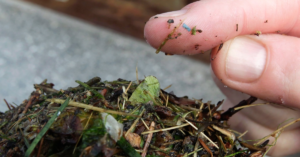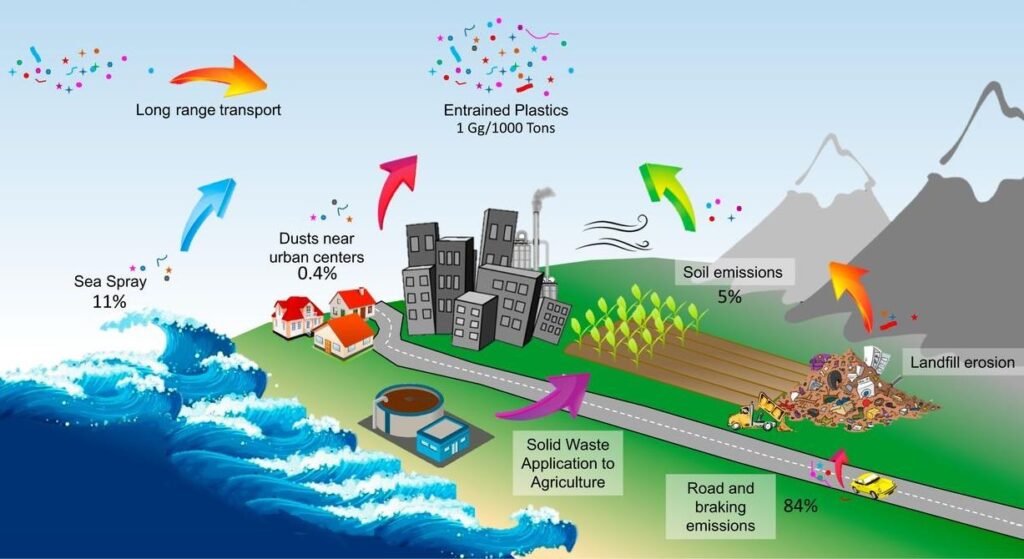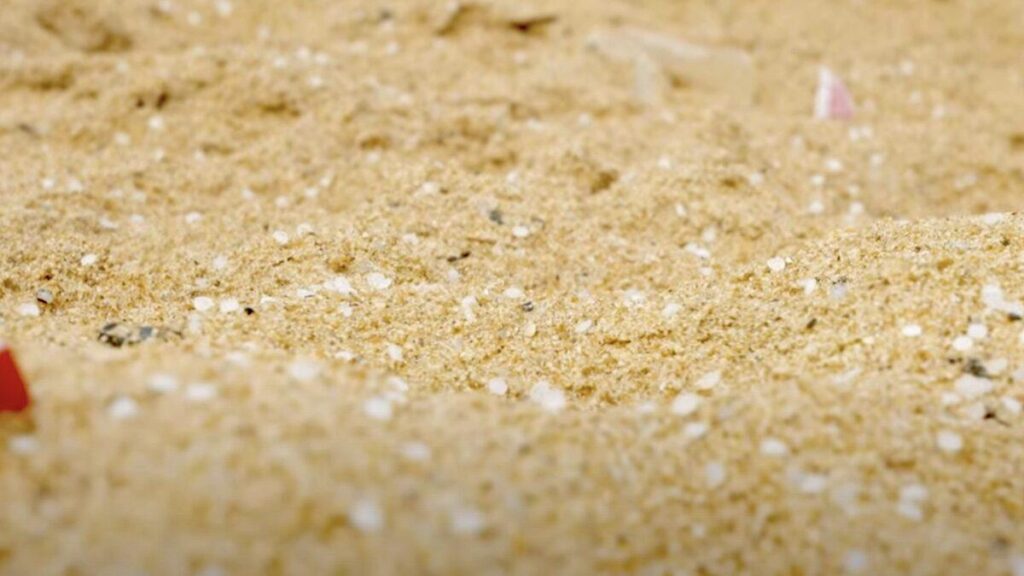Physical Address
23,24,25 & 26, 2nd Floor, Software Technology Park India, Opp: Garware Stadium,MIDC, Chikalthana, Aurangabad, Maharashtra – 431001 India
Physical Address
23,24,25 & 26, 2nd Floor, Software Technology Park India, Opp: Garware Stadium,MIDC, Chikalthana, Aurangabad, Maharashtra – 431001 India

Tiny but mighty troublemakers, microplastics, those minuscule plastic particles measuring 5 mm or less, have stealthily become a global environmental menace. These pint-sized particles pack a punch, raising concerns far beyond their size and making waves as a pervasive and insidious threat to our planet.

In the lens of Ted S. Warren, a blue rectangular piece of microplastic is visible on a researcher’s finger. Source; CTV NEWS
Microplastics stem from the degradation of larger plastic items like bottles and bags through weathering, UV radiation, and mechanical processes, while also being released into the environment including the atmosphere, via the abrasion of synthetic textiles during washing, the wear and tear of vehicle tires, plastic mulch in agriculture, and the overall degradation of plastic products across diverse settings.

Pic courtesy PNAS
Originating from the breakdown of larger plastic items, these microscopic particles pose multifaceted threats to ecosystems, and human health, and, surprisingly, even contribute to climate change.
Global Impact of Microplastics on Climate Change
Microplastics, often invisible to the naked eye, have a significant role in exacerbating climate change. The production, distribution, and mismanagement of plastic contribute to greenhouse gas emissions at various stages of the plastic life cycle. Here are some key aspects of how microplastics contribute to climate change globally:
1. Production Emissions:
The production of plastic, including microplastics, involves the extraction and processing of fossil fuels. The extraction and refining of oil and gas for plastic production release substantial amounts of greenhouse gases, primarily carbon dioxide (CO2). The vast scale of plastic production worldwide makes it a notable contributor to the overall carbon footprint.
2. Microplastics and Carbon Sequestration:
Microplastics in marine environments play a role in disrupting the ocean’s ability to sequester carbon dioxide. Plastics, as they degrade, release substances that hinder the ocean’s carbon absorption capacity. This interference contributes to the accumulation of CO2 in the atmosphere, intensifying the greenhouse effect and global warming.
3. Waste Management Emissions:
The improper disposal and mismanagement of plastic waste, including microplastics, lead to the release of methane—a potent greenhouse gas. Landfills, where a significant portion of plastic waste ends up, generate methane as the waste decomposes anaerobically. Proper waste management is crucial to mitigate these emissions.
4. Impact on Biodiversity:
Microplastics pose threats to various ecosystems, affecting biodiversity and disrupting ecological balance. The disturbance to natural habitats, especially aquatic environments, contributes to the release of stored carbon in ecosystems, further impacting climate change.
Microplastics in the Pearl of the Indian Ocean
Sri Lanka, with its rich biodiversity and scenic landscapes, faces its unique challenges regarding microplastics. While the global implications remain relevant, the specific issues encountered by Sri Lanka underscore the urgency for localized solutions.
As an island nation, Sri Lanka is particularly susceptible to plastic pollution along its extensive coastline. For example, the shores of Sri Lanka have become littered with minuscule plastic pellets known as nurdles, after the sinking of the MV X-Press Pearl cargo ship off the coast of Colombo.

Pic courtesy Alliance to End Plastic Waste
Microplastics infiltrate marine ecosystems, posing threats to marine life and compromising the resilience of coastal ecosystems. Mangroves, vital for carbon sequestration, are particularly vulnerable to plastic contamination.
In the lush landscapes of Sri Lanka, where agriculture forms the heartbeat of the economy, a silent threat emerges as microplastics infiltrate the very soil that sustains the nation. The breakdown of plastic mulch used in farming poses a direct menace to soil health and fertility, casting shadows over the livelihoods of those dependent on the land. Meanwhile, the crystal-clear waters that quench the island’s thirst harbor a hidden peril. Microplastics, stealthy intruders in drinking water sources and even bottled water, raise concerns about public health and the urgent need for meticulous water management.
Amidst the breathtaking beauty that lures global wanderers to Sri Lanka’s shores, a more ominous narrative unfolds. The tourism industry, a vital economic force, grapples with the repercussions of plastic pollution. Microplastics, like elusive whispers, mar the pristine beaches and marine havens, threatening not just the environment but the very lifeblood of the nation’s prosperity. The tale weaves together the threads of agriculture, water, and tourism, painting a portrait of a nation at the crossroads of preserving its natural treasures and securing the well-being of its people.
The Complex Challenge of Microplastics and Climate Change Mitigation
Addressing the complex interplay between microplastics and climate change requires a multi-faceted approach. While reducing plastic production and improving waste management are critical components, it is equally important to recognize the unintentional sources of microplastics and work towards minimizing their contribution. Sri Lanka, like many other nations, must prioritize the following strategies.
Recognizing the intricate web of challenges Encouraging the use of alternatives to single-use plastics and promoting sustainable packaging practices can significantly reduce the generation of microplastics. Public awareness campaigns and policy interventions are essential to drive this shift in consumer behavior. The heartbeat of this endeavor lies in the embrace of robust waste management systems, where recycling and proper disposal become guardians against plastic leakage, safeguarding the island’s natural beauty.
In the pursuit of wisdom, Sri Lanka invests in the realms of research and innovation, seeking to unravel the mysteries of microplastics within its local context. From the laboratories of discovery may emerge biodegradable wonders and advanced filtration miracles, paving the way for a cleaner, more resilient future. As governance takes the spotlight, stringent policies become the orchestrators of change, regulating the entire plastic life cycle and harmonizing efforts to mitigate the profound impact of microplastics on climate change. In this symphony of strategy, Sri Lanka embodies the spirit of global stewardship, weaving a narrative of environmental renaissance for generations to come.

This instrument is sampling airborne microplastics, Pic courtesy Alex Aves
Preserving Ecosystems: A Call to Action
The significance of preserving ecosystems, both globally and in the Sri Lankan context, cannot be overstated. Ecosystems provide essential services such as carbon sequestration, water purification, and habitat support for countless species. As microplastics threaten these ecosystems, the urgency to take action becomes paramount.
By adopting sustainable practices, fostering innovation, and implementing effective policies, we can mitigate the impact of microplastics on climate change. Recognizing that plastic has become deeply ingrained in modern life, a balanced approach involves both reducing plastic use and developing responsible waste management systems.
In conclusion, the fight against microplastics and their contribution to climate change requires collective efforts at the global and local levels. Sri Lanka, with its unique challenges, can serve as a microcosm of the broader struggle to preserve our planet. As we navigate a path toward a sustainable future, the preservation of ecosystems stands as a testament to our commitment to a healthier planet for current and future generations.-With inputs from
–G. R. Diwyanjalee–